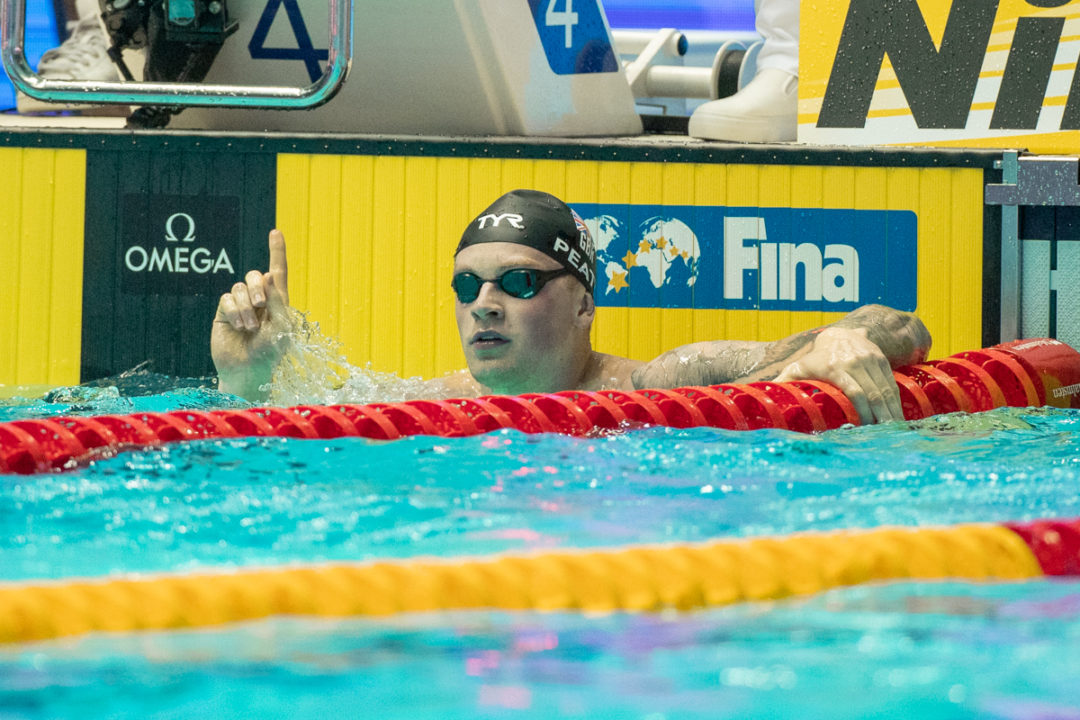Courtesy: Daniel Takata
A couple of days ago, Adam Peaty became the first man to break 57 seconds in the 100 breaststroke as he delivered an incredible 56.88.
He is also the only swimmer to ever break 58 and he has the 17 fastest performances of all time.
No one else has ever swam under 58.29 in the event.
I think I don’t need to explain why this record is one of the most legendary ever.
But what if there would be a swimmer capable of a similar performance in the 100 freestyle? Or in the 200 fly?
To imagine that, I conducted a statistical analysis using a methodology called Extreme Value Theory.
It is based on a scientific paper I wrote with Ligia Henriques-Rodrigues, a professor of the Department of Statistics at São Paulo University, called “Swimming performance index based on extreme value theory” published in the International Journal of Sports Science & Coaching*.
Basically, I took the times of the 150 best performers in each event and modelled the data in order to determine the probability of an specific time be exceeded.
Using Extreme Value Theory, we can determine the theoretic probability distribution of such data – this distribution is called Generalized Pareto distribution.
We now can evaluate the probability of Adam Peaty‘s world record being exceeded in the universe of the 150 best performers of all time. This probability equals to 0.3%.
Similar analysis can be conducted for other events. For example, the probability of Ryan Murphy‘s world record in the 100 backstroke being exceeded equals to 0.91%.
We now can evaluate the time in the 100 backstroke which leads to a probability of 0.3% to be exceeded. This would correspond to the time that matches Adam Peaty‘s world record. Such time is 50.49.
The same analysis is conducted for every other individual male event.
The stronger the time, the less the probability of exceedance.
The probability of the Peaty’s world record to be exceeded is, of course, very small.
What would be the time in the 100 freestyle, or in any other event, to match such probability?
The times are listed below (male events only).
| Event | 56.88 equivalent | World Record |
| 50 free | 20.53 | 20.91 |
| 100 free | 45.71 | 46.91 |
| 200 free | 1:41.72 | 1:42.00 |
| 400 free | 3:35.59 | 3:40.07 |
| 800 free | 7:25.93 | 7:32.12 |
| 1500 free | 14:09.87 | 14:31.02 |
| 50 fly | 21.88 | 22.27 |
| 100 fly | 48.94 | 49.82 |
| 200 fly | 1:49.97 | 1:51.51 |
| 50 back | 23.21 | 24.00 |
| 100 back | 50.49 | 51.85 |
| 200 back | 1:49.60 | 1:51.92 |
| 50 breast | 25.86 | 25.95 |
| 100 breast | 56.88 | 56.88 |
| 200 breast | 2:02.54 | 2:06.67 |
| 200 IM | 1:52.51 | 1:54.00 |
| 400 IM | 3:59.90 | 4:03.84 |
It is really interesting to observe how fast the swimmers would have to be in some events to match Peaty’s record.
It would take 45.71 in the 100 freestyle.
3:35.59 in the 400 freestyle.
50.49 in the 100 backstroke.
2:02.54 in the 200 breaststroke.
And 3:59.90 in the 400 individual medley.
How many years will we have to wait until swimmers are capable of performing like this?
Adam Peaty is truly ahead of our time.
*Daniel Takata Gomes, & Ligia Henriques-Rodrigues (2019). Swimming performance index based on extreme value theory. International Journal of Sports Science & Coaching, 14(1), 51-62.
About Daniel Takata Gomes
 Daniel Takata is editor of Swim Channel Magazine from Brazil, has a PhD in Statistics and is a college professor. He also works as a swimming TV commentator on SporTV and holds a website dedicated to sports analytics, Esportístico (www.esportistico.com.br).
Daniel Takata is editor of Swim Channel Magazine from Brazil, has a PhD in Statistics and is a college professor. He also works as a swimming TV commentator on SporTV and holds a website dedicated to sports analytics, Esportístico (www.esportistico.com.br).

And he’s on a TUE for testosterone. Confirmed by other British swimmers. It’ll be interesting to see if he actually owns up to this.
I guess this all makes tremendous sense on how amazing that record truly is. I do think, as crazy as it sounds, that some of those proportioned records are achievable…I think we just have some work to do in the world…and, scheduling.
the one thing this does not take into account is that Adam Peaty is ONLY a breaststroker. Think of most of the rest of the world records. The Lochte IM record was done when Ryan was in what, 4, 5, 6 events that have prelims-semis-finals? Phelps’s 4:03, while done at the beginning of the olympics, was also part of training for 5 individual races, most of which had to be swum 3x. When Peaty only has to swim… Read more »
This is an interesting analysis. It shows that Adam Peaty has changed the way the stroke is swum. His efficiency in technique is in line with the greatest swimmers in the other strokes.
i absolutely love watching AP swim the breast. It brings back memories of the big 3 from Texas every time they swam it was all eyes on them. because if you were not watching you could miss a clinic of a swim.
How much is this skewed by the amount of times he has swam ridiculous times though?
I think these times in the other events are (if anything) conservative relative to Peaty’s 100.
I misread the article. Disregard above comment.
I don’t think each event is equally ripe for disruption in the way Peaty disrupted 100 breast so I’m not sure this kind of cross event comparison makes much sense.
I’m not quite sure about the stats of the 800 free.
We have 6 men under 7.40 (7 performances in total under 7.40) in history and, besides mellouli 7.35, the first one is 6 seconds behind. Only 56 performances under 7.45 with the 150th performance around 7.49 …
Nice to have a statistical analysis but it would be interesting to see how the times would change if you included best 150 textile swims only. One of the reasons Milak’s Was so good was that the WR that he smashed was Phelps’ supersuit WR. He beat his textile WR by 1.3s and more than 2s over anyone not Phelps. Peaty’s 56.8 would still be our of this world but I think the stats would show Milak’s Wr to be similarly amazing